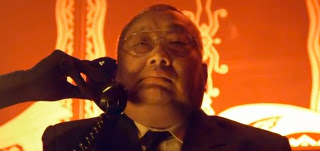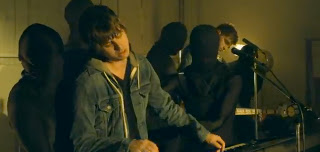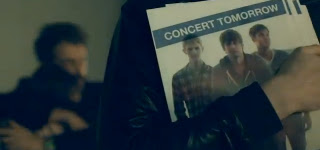The second video I have chosen for my video analysis is 'Houdini' by the Indie Rock band: Foster the People. I have referenced this song and video in my past posts as I find it to be an extremely good video. I have included a video below of me detailing particular aspects of the video which I found particularly good. Below the video is my more detailed analysis of the music video.
Music
Since most of the video is narrative, there are only a few performance point of views but during the performance sections there is a strong relationship between the music and visuals, which we first see when the main riff of the song comes in. This is when the band members are crushed by the stage lighting (image right).

One thing that I picked up on here was one of the crew members holding the lead singer (image left), which is quite a common theme in films where a tragedy has just occurred, and the band's death is seen as a tragedy since they are meant to play a concert tomorrow (image below).

The verse is filled with the narrative section, and in the first verse we see the band's boss/manager hear about the news (image left) at which the dead band members are promptly turned into puppets and acted out by puppeteers in the first chorus (images below).

When the instrumental kicks in the lights turn off and a black backdrop falls down; the band looks as if they are playing their instruments and then proceed to dance as directed by the puppeteers (image below).

In the next verse we see the band being turned into robots which leads up to the instrumental at which they are flung into the air to emphasise the chorus (image below right).

What I think is clever here is the use of overcranking just before the instrumental begins and it reverting back to normal speed to match the pace of the song. There is repeated use of overcranking again in places to emphasise the pace of this part of the song, as well as the lights flashing to hide cuts and keep with the beat of the song (image left).
During the bridge the band is playing at a live gig in front of an audience, the camera capturing the energy of the song and audience through slow-motion of shots of the audience (image right). The lights flashing in time with the beat of the song, the audience jumping up and down and the raised voice of the singer indicate that the song is drawing to a climax which is matched on screen.

As the band jumps up from their instruments the camera follows them and suddenly raises up again to emphasise them landing on the stage, at which they start their dance which has played a key part throughout the song (image left).

A lot of the bridge is filmed from behind the audience to try and make the watcher feel as though they are there in the audience watching the band (image right).

The camera again shows the band's clothes ripped off in slow motion to be replaced with white clothes (image left).
They are joined by more dancers and the camera pans to reveal the audience dancing in unison with the band (image right) which emphasises the audience's enjoyment, thus influencing how the watcher feels about the song.
The singers voice raising in tempo and sound to draw the bridge to a close at which point the band members are again with their instruments and confetti shoots into the air (image left).
The outro plays in with the visuals as one long shot is showing all the workers are celebrating, the song and video ending on the 3 band members lying on a sofa (we as the audience are to presume they have been shut down as they are robots) (clip below).
Lyrics
Pre-chorus:
Got shackles on, my words are tied / Fear can make you compromise / Fast enough it's hard to hide / Sometimes I want to disappear
"My words are tied / fear can make you compromise" means that no matter how much you prepare for a speech, or debate, or any other type of public speaking, when you stand up there for real, you experience distress and you suddenly forget everything you're about to say. And what do you do when you forget everything? You feel embarrassed, and you want to "disappear."
After the chorus is repeated for a second time, a second voice is added to the song, and I believe this is the person's subconsciousness telling them to stand up, and focus on their ability, what they've prepared so long for, and that they have nothing to fear.
Bridge:
"Gain again what they want to steal / Gain again what they want to steal / Gonna gain again what they want to steal / Gain again what they want to steal"
"They" are the audience. The people who mock the speaker for their lack of bravery. What they want to "steal" is his self-esteem- that is, they want to take his confidence away, and the presence of them makes the speaker gravely embarrassed. To "gain again" what they want to "steal" means to recover from the initial shock of standing in front of your peers, gather up your self-esteem again, and just do it.

There are certain points at which the lyrics tie in with the visuals, which we first see when the singer is being turned into a robot and the scientists are trying out his lips at pronouncing the words (image left).
I think the best representation of the lyrics however is the dance that keeps repeating, as the whole song is about ability, the band is showing their ability through the dance. The second voice keeps repeating ability in the bridge which directly relates to the band members being turned into robots, inclining at the fact that band managers want ability which is something that humans do not have but robot band members do.
Concept
I reckon the song is called Houdini because he was an escape artist, and this shows that you can't escape from the music company`s hands, even if you die you will be used as a puppet in the music industry which is clearly illustrated throughout the video. I believe the actual song is centered around ability (which links to the robots having more ability than humans), and about standing up for yourself in spite of your peers using your ability. It addresses important aspects of the music industry revolving around companies and managers, that they will use people even when they are dead to get money. This video raises some important notions of the music business, especially from the point of view of the artist(s). Mark Foster (the band's lead singer and songwriter) is trying to express how sometimes the music industry and artists are controlled by the producers, and how they are willing to go to any lengths to make sure they get money out of the artist (as seen by the band's boss in the video).









No comments:
Post a Comment